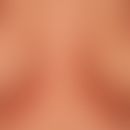DefinitionThis section has been translated automatically.
Ichthyosis follicularis - alopecia - photophobia syndrome, or IFAP, is a rare genetic, X-linked disorder characterized by the triad of ichthyosis follicularis, alopecia and photophobia.
Occurrence/EpidemiologyThis section has been translated automatically.
<1 / 1 000 000
You might also be interested in
EtiopathogenesisThis section has been translated automatically.
The cause of the disease is mutations in the MBTPS2 gene (Xp22.12-p22.11), resulting in a disruption of cholesterol homeostasis and an endoplasmic reticulum stress response.
Clinical featuresThis section has been translated automatically.
Congenital follicular ichthyosis, alopecia, absent eyebrows and eyelashes, and photophobia (occurring in the first year of life, infancy, or early childhood); the scalp is most severely affected, as well as the extensor sides of the extremities. Characteristic is the non-scarring complete hairlessness (atrichia) of the body.
Newborns may have varying degrees of collodion membranes. Psoriasiform plaques, cheilitis of the corners of the mouth, nail bed inflammation, nail dystrophy, hypohidrosis, and features of atopic dermatitis are other possible symptoms. Palms and soles are usually not involved.
Also possible: mild to severe intellectual deficits, short stature, microcephaly, seizures, dysmorphia (balcony forehead, large ears), choanal atresia, split hand, abnormalities of the intestinal tract (omphalocele, Hirschsprung's disease, small bowel stenosis, and abnormalities of the kidneys, heart, and vertebrae. Recurrent infections are common. Except for rare cases with cryptorchidism or hypospadias, the external genitalia are usually normal. Carriers may show milder symptoms (hyperkeratosis following the Blaschko lines, asymmetric distribution of body hair, patchy alopecia).
DiagnosisThis section has been translated automatically.
Clinic and analysis of mutations in the MBTPS2 gene.
Complication(s)This section has been translated automatically.
Superficial ulcers of the cornea lead to their progressive scarring.
TherapyThis section has been translated automatically.
Follicular hyperkeratosis can be treated with topical keratolytics, emollients, and urea preparations. Some patients showed a moderate response to treatment with the retinoid acitretin. Intensive moisturization of the ocular surface is important.
Progression/forecastThis section has been translated automatically.
The prognosis varies. Some patients die as newborns, others have a normal life expectancy. Loss of visual acuity often leads to loss of autonomy. Causes of death are often cardiac and pulmonary complications.
LiteratureThis section has been translated automatically.
- Jiang Y et al (2019) A novel mutation in MBTPS2 causes ichthyosis follicularis, alopecia, and photophobia syndrome. Mol Genet Genomic Med 7:e812.
- Irurzun I et al. (2021) Ichthyosis follicularis, atrichia and photophobia (IFAP) and hereditary mucoepithelial dysplasia: Two syndromes that share a common clinical spectrum. Pediatr Dermatol 38:568-574.
- Murase C et al. (2021) Hereditary mucoepithelial dysplasia and autosomal-dominant IFAP syndrome Is a Clinical Spectrum Due to SREBF1 Variants. J Invest Dermatol 141:1596-1598.
Disclaimer
Please ask your physician for a reliable diagnosis. This website is only meant as a reference.




